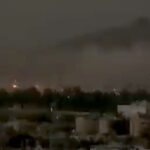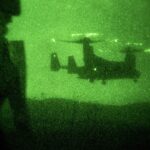Vice President Mike Pence announced that the US and Turkey reached a deal to suspend the Turkish military offensive in Northeastern (NE) Syria. After tense negotiations in Ankara, Turkish President Erdogan agreed to a 120 hour long ceasefire on Thursday. The ceasefire grants the Kurdish “Peoples’ Protection Units” (or YPG) 120 hours to withdraw 32 km from the Turkish border.
The YPG and the “Syrian National Army” (SNA), which is spearheading Turkey’s ground offensive in NE Syria, both stated that they will respect the agreement. James Jeffrey, the US Special Envoy for Syria, said that the agreement will be focused on “those areas where the Turks had penetrated into northeast Syria.” This suggests that the buffer zone will encompass the territory between Tel Abyad and the outskirts of (or the city of) Serekaniye on an east-west axis and reach 32 km south up to the M4 highway. President Erdogan has committed to stop the Turkish-Rebel incursion in NE Syria, after SNA forces will occupy this area.
While the agreement brings a welcome pause to the violent clashes along the Turkish-Syrian border, it essentially validates most of Erdogan’s military objectives in the area. The aim of Turkey’s Operation “Peace Spring” is to remove the YPG from the border area and to secure a buffer zone, where 3 million Syrian refugees will be relocated. Since the operation commenced a week ago, the SNA has struggled to break through YPG defenses. The agreed withdrawal of the Kurdish militia from the area will allow the SNA to make major advances without encountering heavy resistance. On the upside, YPG has a chance to safely evacuate Serekaniye, a border town besieged by Turkish artillery and SNA infantry. In the meanwhile, the Turkish Armed Forces will likely seek to further entrench themselves in the area by building combat outposts and defensive fortifications.
#PeaceSpringOperation: #Turkey sets up new #military posts in #Syria. pic.twitter.com/CjqbOhJv2b
— ImageSat Intl. (@ImageSatIntl) October 17, 2019
The international community fears that the Turkish-backed SNA will commit war crimes and displace the Kurdish population in the area, as seen during Operation “Olive Branch” in northwestern Aleppo province. The SNA is coalition of Arab and Turkmen Sunni armed opposition groups that were in the past loosely known as the “Free Syrian Army.” Despite the re-branding, the SNA essentially remains a hotchpotch of hardline Islamist groups.
The YPG is the military wing of the Syria-based Democratic Union Party (or PYD) and provided for the vast majority of fighters and the entire senior command of the U.S-trained and equipped Syrian Democratic Forces (SDF). The PYD has undeniable links to the PKK, a Kuridish separatist and social-revolutionary militia engaged in a violent insurgency against the Turkish state. During the Coalition’s fight against ISIS, the YPG received sophisticated weapons and training from the US military. Ankara fears that these new capabilities could be used to attack Turkey. Due to this concern, it is unlikely that Turkey will put a stop to military action against the YPG after the agreement is implemented.
- Russia Bombs Maternity Ward & Children’s Hospital in Mariupol As Part of Siege - 10 March 2022
- T-Intell’s OSINT Training Marks One Year Anniversary - 18 November 2021
- IS-K Never Left the Battlefield - 27 August 2021





